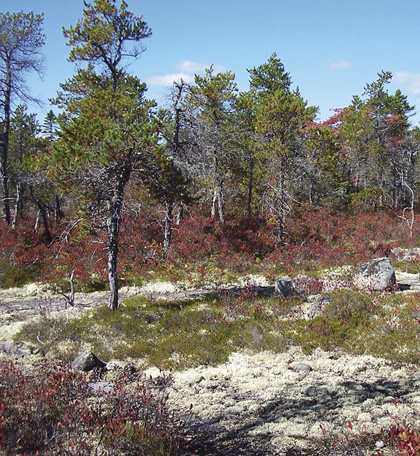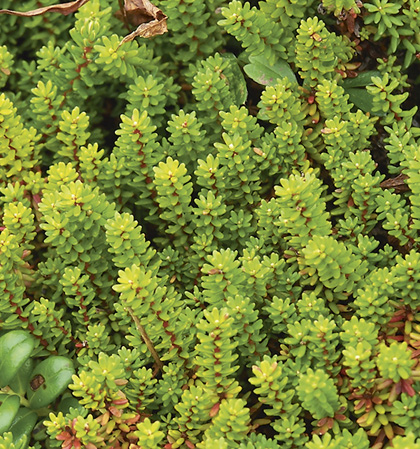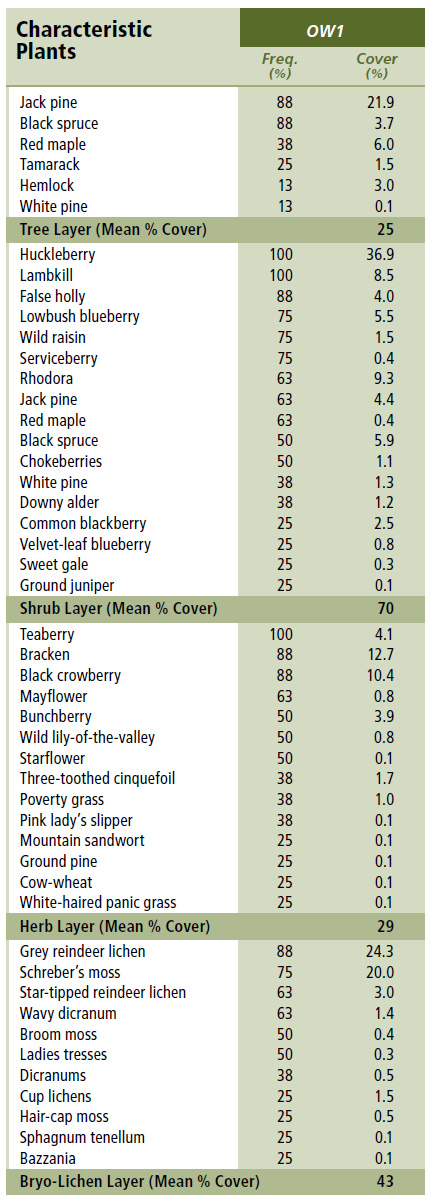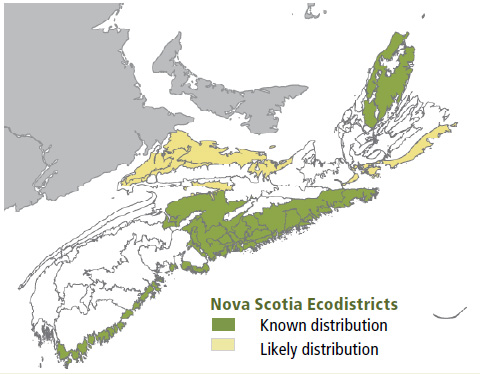
Forest Vegetation types - OW1
OW1 — Jack Pine / Huckleberry / Black crowberry / Reindeer lichen
Pinus banksiana / Gaylussacia baccata / Empetrum nigrum / Cladina spp.
 |
Blandford, Lunenburg County |
Concept: This open coniferous woodland is characterized by jack pine canopy dominance, thin acidic soils and prominent reindeer lichen, black crowberry and huckleberry cover. It is found on exposed rock ridges or thin glacial till, where it may co-occur with SP1 (Jack pine / Bracken – Teaberry forest). OW1 is typically on very-dry to dry sites, but occasionally occurs on moister soil, usually with thicker organic layers.
Vegetation: The canopy has low to moderate crown closure and is usually dominated by jack pine or co-dominated by jack pine and black spruce. Few other tree species are represented. The very well-developed woody understory features high huckleberry cover, with lesser but frequent rhodora, lambkill and low bush blueberry. Herb cover and species richness is reduced, although dwarf heaths like black crowberry and less often, broom crowberry, are characteristic, especially in coastal areas. The dense lichen layer is characterized by grey, green, lesser green and star-tipped reindeer lichen species.
Environmental Setting: This low elevation ecosystem is found in areas where thin acidic soils, exposed bedrock and cool climatic conditions limit plant productivity and species richness. It occurs on upper slopes and crests of rocky hill crests and ridges, and on flatter, usually thin, glacial deposit. Soils are usually dry, nutrient very poor, coarse textured and stony. Microtopography is reduced, while site exposure is very high. The ecosystem occurs in the Atlantic Coastal and Eastern ecoregions, with outliers on the coastal fringe of the Cape Breton Highlands. This relatively uncommon Vegetation Type (VT) is also rare in New Brunswick. It isn't known from anywhere else in Canada.
Successional Dynamics:The Jack pine / Huckleberry / Black crowberry / Reindeer lichen woodland is expressed as an early successional stage, but is not expected to advance to later successional stages. Shallow, nutrient very poor soils and exposure generally prevent the transition to other pine or black spruce vegetation types. The VT persists as an edaphic climax but is also strongly shaped by harsh climatic factors (e.g. strong desiccating (drying) winds, cool temperatures and sometimes salt spray). Fire is a component of stand history in some stands but is not required for ecosystem persistence, because serotinous (refers to cones which remain closed until opened by excessive heat, usually from fires) jack pine cones often open and release seed without fire in these woodlands. Other disturbances include windthrow and breakage.
Ecological Features:This nationally unique, range-limited ecosystem is one of the least common VTs, largely isolated to cool dry ridges and hill tops. These sites are somewhat prone to lightning strikes that may help maintain jack pine dominance. The rocky woodland's most remarkable features include its rarity, restricted distribution, and relatively specific environmental requirements. These collectively contribute to OW1's high vulnerability, presenting unique conservation challenges. The Jack pine / Huckleberry / Black crowberry / Reindeer lichen woodland supports uncommon habitat conditions, but associated animal and lichen species are undocumented. This small patch ecosystem may provide plant habitat for mountain sandwort, red crowberry and a small group of flora with Atlantic Coastal Plain affinities (e.g. inkberry, broom crowberry and pine barren goldenheather). It supports an open, sometimes stunted, canopy with abundant shrub and lichen cover. Productivity, tree age, canopy height and old growth potential are all low.
 |
| Black crowberry |
Distinguishing Features: A woodland characterized by scattered jack pine, exposed bedrock and prominent reindeer lichen, black crowberry and huckleberry cover.
| Slope Position: | Crest3 Level3 Upper3 Middle1 |
Surface Stoniness: |
(Non - Slightly)6 (Very - Excessively)3 nd1 |
Bedrock Outcrop: |
(Very - Excessively)6 (Slightly - Moderately)3 nd1 |
Elevation Range: |
22 - 108m |
Slope Gradient: |
Level4 Gentle3 nd3 |
Aspect: |
South1 West3 None6 |
Exposure: |
Exposed7 Other2 nd1 |
Microtopography: |
Level8 Slightly1 nd1 |
Drainage: |
Rapid5 Imperfect3 Moderately well1 nd1 |
Soil Type: |
ST156 ST21ST61 ST15-G1 ST161 |
Parent Material: |
Bedrock5 Glacial till3 Organic/Bedrock1Till/Bedrock1 |
Rooting Depth (cm): |
(<30)5 (30-45)3 nd2 |
Duff Thickness (cm): |
(6-10)4 (11-20)2 nd4 |

